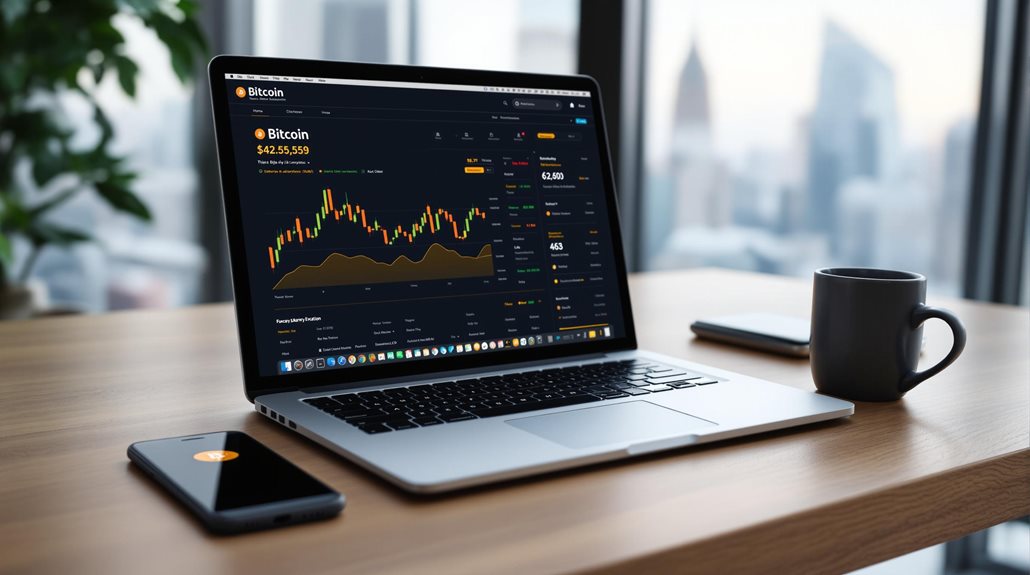Dollar cost averaging (DCA) in crypto means investing fixed amounts at regular intervals, like weekly or monthly, instead of buying all at once. It's a method that helps reduce the impact of market volatility by spreading out purchases over time. Many crypto exchanges offer automatic purchase features to make this easier. DCA typically works best over longer periods, often five years or more, regardless of market ups and downs. There's much more to understand about making DCA work effectively.

Dollar cost averaging, also known as DCA, is one of the simplest ways to invest in cryptocurrency over time. It's a method where investors put in fixed amounts of money at regular intervals, regardless of the market price. This approach helps reduce the impact of crypto's notorious price swings and takes the pressure off trying to guess the perfect time to buy.
The process works by spreading out purchases over time instead of investing all at once. For example, rather than spending $1,200 on Bitcoin in one go, someone might invest $100 every month for a year. This strategy means they'll buy more crypto when prices are low and less when prices are high, potentially resulting in a better average purchase price over time. Studies show that lump sum investing can outperform DCA if timed correctly during price drops.
DCA has gained popularity in the crypto world because it helps investors manage the extreme volatility of digital assets. It's particularly useful for beginners who aren't familiar with market analysis or experienced investors who want to maintain a steady investment approach. The strategy removes much of the emotional decision-making that often leads to poor investment choices during market ups and downs. DCA is especially beneficial during market downturns, as it allows investors to consistently accumulate assets at lower prices. The emotional detachment provided by DCA helps prevent panic selling and impulsive buying decisions. The absence of intermediaries in decentralized networks makes DCA an even more cost-effective strategy for long-term crypto investing.
Setting up a DCA strategy involves several key elements. Investors first select which cryptocurrencies they want to buy regularly. They then decide how much money they can commit based on their budget and choose how often they'll make purchases – whether weekly, monthly, or at other intervals. Many crypto exchanges now offer automatic purchase features that make this process even easier.
While DCA offers several benefits, it's important to understand its limitations. In markets that consistently rise, investing a lump sum might actually produce better returns. The strategy requires commitment and discipline to maintain regular investments, especially during market downturns. It's also not suitable for those looking to make quick profits through short-term trading.
Research suggests that DCA works best when maintained for longer periods, typically five years or more. This timeframe allows the strategy to work through various market cycles and potentially benefit from the long-term growth of chosen crypto assets.
However, like any investment approach, DCA doesn't guarantee profits, and investors can still lose money if the overall market declines considerably over time. The success of this strategy ultimately depends on the long-term performance of the selected cryptocurrencies and the investor's ability to maintain consistent investments regardless of market conditions.
Frequently Asked Questions
Can You Use Multiple Crypto Exchanges for Dollar Cost Averaging?
Yes, investors can use multiple cryptocurrency exchanges for dollar cost averaging.
It's a common practice that offers both benefits and challenges. Using several exchanges lets people spread their risk, access more cryptocurrency options, and potentially find better prices.
However, it also means dealing with multiple accounts, more complex tracking, and increased security considerations.
Some investors use special tools to help manage their investments across different exchanges more efficiently.
What Time of Day Is Best to Schedule Recurring Crypto Purchases?
Data shows that 12-1 PM Eastern Time has the highest odds of catching daily low prices in crypto markets.
During this window, there's a 6.28% chance of buying at the daily low versus 1.91% chance of hitting the daily high.
For weekly purchases, Mondays historically offer the best opportunity, with a 14.36% advantage compared to the week's average price.
These patterns exist but aren't guaranteed to continue long-term.
Should You Dollar Cost Average Into More Than One Cryptocurrency?
Dollar cost averaging into multiple cryptocurrencies is a common strategy many investors use to spread out their risk.
It's like not putting all your eggs in one basket. Some people choose to buy both Bitcoin and Ethereum, while others add smaller cryptocurrencies to their portfolio.
While this approach can offer more diversification, it also means keeping track of more investments and paying more transaction fees.
The strategy's results vary for different investors.
How Do Taxes Work With Automated Cryptocurrency Purchasing Schedules?
Each automated crypto purchase creates a new tax record that needs tracking.
The IRS treats crypto as property, so buyers must record the purchase price and date for every transaction.
When someone sells their crypto, they'll need these records to figure out their gains or losses.
While some exchange platforms provide transaction histories, it's still up to the investor to keep detailed records of their automated buys.
Is It Better to Dollar Cost Average Weekly or Monthly?
Neither weekly nor monthly dollar cost averaging is definitively "better" – each has distinct advantages.
Weekly DCA captures more price movements and builds positions faster, while monthly DCA typically involves lower fees and less management time.
The choice often depends on individual circumstances like budget, transaction costs, and time available for investment management.
Some investors even combine approaches, using weekly DCA for volatile assets and monthly for stable ones.





